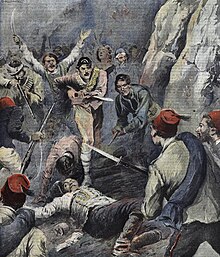
Back الثورة الألبانية (1910) Arabic Albaniya üsyanı (1910) AZ Албанско въстание (1910) Bulgarian המרד האלבני (1910) HE Pemberontakan Albania 1910 Malay Revolta Albanesa de 1910 Portuguese Kryengritja e vitit 1910 SQ Албански устанак (1910) Serbian Albanska revolten 1910 Swedish 1910 Arnavut İsyanı Turkish
| Albanian revolt of 1910 | |||||||
|---|---|---|---|---|---|---|---|
 Depiction of the revolt by The Illustrated Tribune, August 1910 | |||||||
| |||||||
| Belligerents | |||||||
| Albanian rebels |
| ||||||
| Commanders and leaders | |||||||
|
Isa Boletini Idriz Seferi Nazif Grazhdani Dine Maqellara Sherif Langu |
Mahmud Shevket Pasha Mehmed Pasha Mustafa Kemal Pasha | ||||||
| Strength | |||||||
| Unknown | Unknown | ||||||
The Albanian revolt of 1910 (Albanian: Kryengritja e vitit 1910, lit. 'Uprising of 1910', in Albanian historiography) was a reaction to the new centralization policies of the Young Turk Ottoman government in Albania.[1] It was the first of a series of major uprisings. Rebels were supported by the Kingdom of Serbia.[2] New taxes levied in the early months of 1910 led to Isa Boletini's activity to convince Albanian leaders who had already been involved in a 1909 uprising to try another revolt against the Ottoman Empire. The Albanian attacks on the Ottomans in Priştine (now Pristina) and Ferizovik (now Ferizaj), the killing of the Ottoman commander in İpek (now Pejë), and the insurgents' blocking of the railway to Skopje at the Kaçanik Pass led to the Ottoman government's declaration of martial law in the area.
After two weeks of fierce fighting the Albanian forces withdrew to the Drenica region, whereas the Ottoman army took possession of the cities of Prizren and Yakova (now Gjakova). The Ottomans retook İpek on 1 June 1910 and two months later they entered Shkodër. The reprisals against the Albanian population included several summary executions, and the burning of many villages and properties. Many schools were closed, and publications in the Albanian alphabet, which had been approved two years earlier, in the Congress of Manastir, were declared illegal. Journalists and publishers were fined or sentenced to death.
- ^ Akçam 2004, p. 129
- ^ John R. Lampe (28 March 2000). Yugoslavia as History: Twice There Was a Country. Cambridge University Press. p. 92. ISBN 978-0-521-77401-7. Retrieved 22 July 2013.
By 1910, an armed Albanian revolt was spreading from Pristina, ironically supported by aid of Serbia.